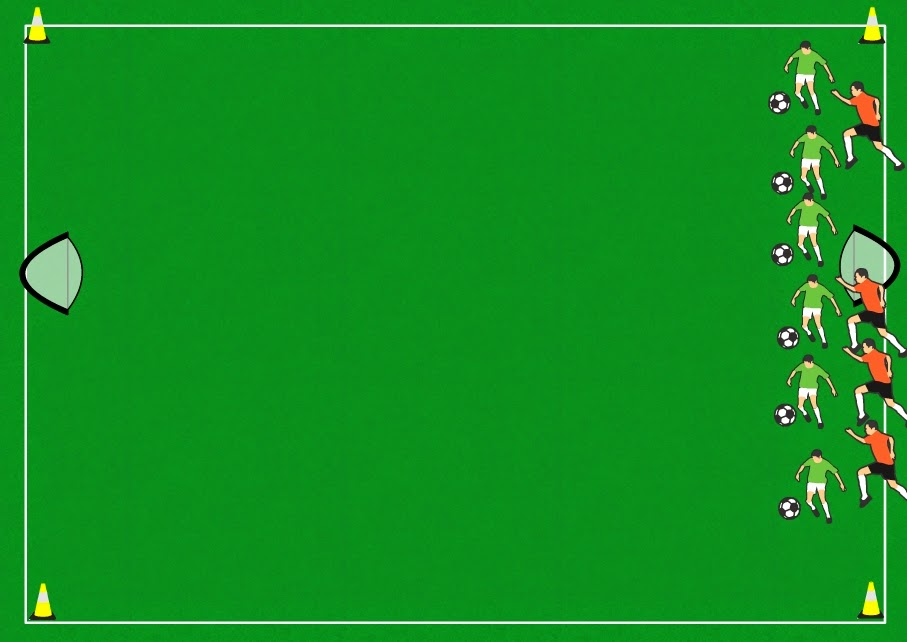passing
In the basketball movie "Hoosiers" Gene Hackman plays the coach. During the season, he decides that they don't share the ball enough, so he sets up a race from one end of the court to the other. The players select the fastest player to dribble down the court. Coach Dale starts the race and then throws the ball to the other end of the court, easily beating the dribbler down the court. His point was that passing is more effective at moving the ball around the field than dribbling. Now you know that I prefer you to focus on dribbling first and there is an important reason for that which I have shared with you often enough, but that doesn't mean you should ignore passing/moving/receiving the ball as part of your player development. It is just that you need to do it at the right time.
While I emphasize three core skills (dribbling, controlling the ball, shield and turn) during my group sessions, I do also work on passing with my U10 and older players starting during the middle of the season. There are a lot of things to work on when coaching passing, but from my perspective there are a few really important concepts:
There are literally thousands of practice plans out there that involve passing, but you need to be selective. If you go into my U10 and U12 coaching resources, you will find some good examples. Here is a link to another post that might make more sense to your players: pass the puppy post
While I emphasize three core skills (dribbling, controlling the ball, shield and turn) during my group sessions, I do also work on passing with my U10 and older players starting during the middle of the season. There are a lot of things to work on when coaching passing, but from my perspective there are a few really important concepts:
- It is pass and move you are teaching, not just passing.
- players need to immediately move to a new location after they pass and not stand in the same place and enjoy the afterglow of a pass well made.
- maintain your balance after you pass (especially inside foot)
- most players land immediately on their passing foot after contacting the ball.
- keeping the foot up and balancing on the supporting leg allows the player to more quickly make the next move (to a new location, see #1)
- try to make it easy on your teammate.
- make the kind of pass that you wish to receive from your teammates.
- a ball that is easy to control makes your teammates job easier and increases the likelihood that your team can keep the ball.
- never pass to a teammate who isn't moving
- players need to learn to make decisions about who to give the ball to when passing. One of the best visual cues is whether or not the teammate is moving.
- if the teammate is not moving, then it is likely that the pass will get intercepted by a defender who is moving.
- never pass to a teammate who isn't asking for the ball
- players who aren't asking for the ball don't want the ball.
- passing the ball to a player who doesn't want it is going to end up in a turnover.
- corollary- just because someone asks for the ball (and is moving) doesn't mean you have to pass it.
- often kids justify a decision to pass not because it helps their team but because they don't want to handle the ball.
- pass using both feet.
- developing the "weak" foot gives a player more options for solving problems if s/he can use both feet to pass effectively.
- you can put a right footed player on the left or right side of the field.
- players who play centrally MUST be able to pass with both feet.
- pass using different surfaces of your foot.
- While most players are first taught passing using inside foot, there are other surfaces that should be taught as well.
- outside foot passing is excellent to use during a give and go.
- outside foot can put a different spin to the ball that curves it into the path of a player and away from a defender.
- each surface causes the ball to travel in a different trajectory, the more you are comfortable with the easier it is to solve problems.
- pass at different levels- on the ground, driven, flighted.
- driven balls travel very quickly and have a flat trajectory. It is useful for changing the point of attack from one side of the field to the other or passing to the near post on a corner or cross to beat the goalkeeper to the ball.
- flighted balls can get the ball to drop over a restraining line or can drop in behind the goalkeeper on a corner kick.
- the pass tells the receiver what you think should happen next.
- you communicate information to your teammate when you pass the ball.
- want that player to pass the ball back to you? pass it to his back foot.
- want that player to penetrate or turn and face the defense? pass it to his front foot.
- passing the ball softly? you want your teammate to come to the ball and separate from a defender.
- making a hard pass? your teammate has a defender nearby but you think he can beat him and you want to give him more time to do it.
There are literally thousands of practice plans out there that involve passing, but you need to be selective. If you go into my U10 and U12 coaching resources, you will find some good examples. Here is a link to another post that might make more sense to your players: pass the puppy post


Comments
Post a Comment